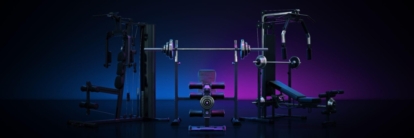With Studio Society’s brand new Strength Studio up and running in full swing, we want to take a second to delve a bit deeper into functional strength training, specifically how it relates to the hamstring muscles. If you’re thinking of getting started on your fitness journey –or have already taken the first steps– then understanding what functional strength training is and how to get the most out of it can help you reach your goal of beautifully sculpted hamstring muscles in less time, while simultaneously making you stronger and more equipped to deal with the physical challenges of everyday life.
So what is functional strength training anyways? While different trainers and articles would argue over exactly what it entails, we see it as specific exercises and techniques that enhance and facilitate the continuum of movement. If you’re a normal, healthy adult, then you probably spend at least some time standing, walking, running, climbing, pushing, lifting, dancing, or doing a whole range of other motions that require a group of muscles to complete. Functional strength training aims to strengthen these muscle groups as a whole, as opposed to fixating on a single muscle at a time, by improving the working coordinated relationship between muscle groups and nerves. This makes performing many of these activities easier, reduces the chance of injury, and helps create lean, sculpted muscles.
Continue reading to see how Studio Society can help you develop lean, toned, and strong hamstring muscles using functional strength training. Go directly to the exercises.
Understanding functional strength hamstring workouts
Just like with most things in life, understanding the process of functional strength training and how to do it right will yield faster and better results than simply winging it. Let’s start by taking a closer look at the hamstring muscles at 3 different levels: where they are, their role in supporting everyday movement, and the effects that functional strength has on them.
Your hamstrings actually consist of a group of three individual muscles that work together. They play a critical role in enabling a wide range of everyday motions, from simply standing to explosive actions such as sprinting and jumping. They span the back of your upper leg, stretching from the pelvis down the leg, and are attached to the tibia and fibula bones below the knee joint.
It’s important to note that the hamstring muscles don’t work in isolation. Our bodies’ movement is a carefully coordinated dance between different groups of muscles, and even basic actions such as standing require coordination between the hamstrings, gastrocnemius (calf muscles), and the gluteals located in the buttocks. Since the goal of functional strength training is to improve our ability to perform the full range of movements required of humans, many of the recommended exercises will not only improve the strength, mobility, and endurance of the hamstrings but will also, to some extent, develop the abovementioned supporting muscles.
The benefits of functional strength training have been studied and proven to a great extent, and the benefits of strong, limber, mobile, and enduring hamstrings are well documented and understood. They provide better support to the hip and knee joints, enhance performance and functional movements, and reduce the risk of hamstring injuries such as painful strains or sprains. Properly trained hamstring muscles also help improve posture, stability, and overall functional fitness. Finally, there’s the obvious benefit of creating those lean, sculpted, and athletic-looking legs we all want. The combined effect of all these benefits makes working out your hamstrings an important part of a well-rounded fitness programme.
Just like any other muscle in your body, the hamstrings are susceptible to injury if you train incorrectly, overtrain, or make the wrong movement while the muscle is under tension. While no muscle injury is something to celebrate, hamstring injuries are especially unpleasant to deal with as we use them for so many of our daily movements. I’m sure every reader here has, at some point in their lives, ‘pulled their hammy’ and spent a few days hobbling along, waiting for it to recover. In more severe cases, a hamstring injury might have you depending on crutches to get around for a while, and in the worst-case scenario, might require surgery or longer-term rehabilitation to repair the damage.
For these reasons, it’s important to take great care when exercising your hamstrings. Proper form, the right level of resistance, and building up towards a goal at a reasonable and understood pace are critical to avoiding injury and putting yourself on the sidelines for up to weeks at a time. While there’s absolutely nothing wrong with attempting any sort of hamstring exercise on your own, doing so with the guidance of a professional trainer or fitness coach can be a very good idea. This is especially true if you are just starting out on your fitness journey, recovering from a previous injury, or have limited experience with leg exercises. They can help you get started at the right level, help you improve your form and range of motion, help you set achievable and realistic goals, and most importantly, help prevent injury

Functional Strength Hamstring Exercises
The exercises listed here are commonly prescribed by fitness trainers to improve the overall strength, endurance, and shape of the hamstring muscles. Unlike isolation exercises that only work a specific muscle (or group), these exercises are considered compound exercises. This means that they not only target the hamstring, but other supporting muscle groups as well. Regularly performing these exercises with the correct form can quickly help you shape, tone, and sculpt your hamstrings for a fitter, more agile, and mobile you.
Studio Society strongly recommends doing at least a couple of sessions with a fitness professional to help you get used to the range of motions and improve your form. This will dramatically improve the rate at which you see results, and reduce the chances of sustaining an injury. If you cannot see a professional trainer, we recommend watching some YouTube videos to study the correct form and movement.

1. Kettlebell Swings
Kettlebell swings are a popular and effective exercise that targets the hips and hamstring muscles. The swinging motion involves a combination of hip hinge, leg extension, and core engagement, and builds strength, power, and cardiovascular endurance. While primarily focusing on the hamstrings, kettlebell swings provide a full-body workout, making them a versatile addition to any fitness programme. To perform kettlebell swings with good form, stand with your feet shoulder-width apart and grab the kettlebell firmly with both hands, lifting it up in front of your chest with arms outstretched. Swing the kettlebell down between your legs with your arms still straight. Hinge forward at your hips, extending your legs. When the kettlebell is as far behind your legs as will allow, swing it back up in front of your chest,
standing up as it swings.
2. Swiss Ball Hamstring Curls
Swiss ball hamstring curls can be challenging at first, especially if you have poor stability. Luckily, you’ll quickly get the hang of it as you strengthen both your hamstrings, core, and balance. Start by lying on your back with your heels elevated on the Swiss ball. Rest your arms at your side. Using your glutes and hamstrings, lift your hips off the floor until your body forms a straight line from neck to toe. This is the starting position. From here, bring your knees up towards your stomach, rolling the ball under your feet. Stop once the soles of your feet are flat on the Swiss ball. The Swiss ball will roll towards you. Roll back in a smooth motion.
3. Bulgarian Split Squat
Bulgarian split squats are a challenging but effective exercise that targets all the major muscle groups in the upper leg and buttocks. Start by standing with one foot forward and the other resting on an elevated platform behind you. Gym benches work great for this, but you could substitute a Swiss ball for an additional challenge. Lower your body into a lunge position, making sure to keep your front knee in line with your ankle and your back knee hovering just above the ground. Push through your front heel to stand back up. Repeat the desired number of times, then switch legs. Bulgarian split squats improve balance, stability, overall lower body strength, and flexibility.
4. Single-leg Glute Bridge
The single-leg glute bridge is a good exercise for beginners. It requires little in the way of equipment, is fairly easy to perform with the correct form, and offers improvements to hamstring strength and form, stability, and balance. Start by lying on your back on a yoga or exercise mat with your knees bent and feet flat on the floor. Lift one leg off the ground, but keep the knee slightly bent. Push off the floor with the other leg, but don’t twist your hips to either side. Try to keep them stable and parallel to the ground. Repeat the desired number of times, then switch legs.
5. Barbell Glute Bridge
A barbell glute bridge can be seen as an upgrade to the single-leg glute bridge. It involves working out the same muscle groups and provides the same benefits, but incorporates the added weight of a barbell for additional resistance. Start by lying on a yoga mat with a barbell (with or without additional weights) lying over your hip bones, your knees bent, soles of your feet flat on the mat. Lift your hips with the weight directly upward, holding the barbell in place with your hands. Again, make sure not to shift your weight to either side, but stay parallel to the ground and use slow, controlled movements.
6. Nordic Hamstring Curl
Nording hamstring curls are arguably the most advanced hamstring exercise on this list. It can be quite challenging to perform even just a few reps, and might not be suitable if you are recovering from an injury or are absolutely new to working out. This exercise also requires a partner or trainer to help secure your ankles. Start by kneeling on a soft surface with your body vertical and in a straight line. Have your partner firmly press down on your ankles to secure them in place. Lean forward to the point of maximum stretch, then pull yourself back up to the starting position. If you can’t pull yourself back up, another variation of this exercise is to fall forward after reaching maximum stretch, then return to the starting position using a push-up motion.
7. Rowing
Rowing is widely regarded as one of the best overall full-body workouts in the gym. While it doesn’t specifically target the hamstrings, they definitely benefit from a good rowing session when done right. Start by sitting on the seat with your feet secured in the footrests, grasping the handle with an overhand grip. Begin the motion by pushing off with your legs, then slightly lean back and pull the handle towards your chest, mimicking the motion of rowing. Reverse the motion by extending your arms, leaning forward, and bending your knees.
Getting the motion absolutely right might take a few minutes, but once you’ve got it, it should feel very natural and intuitive.
